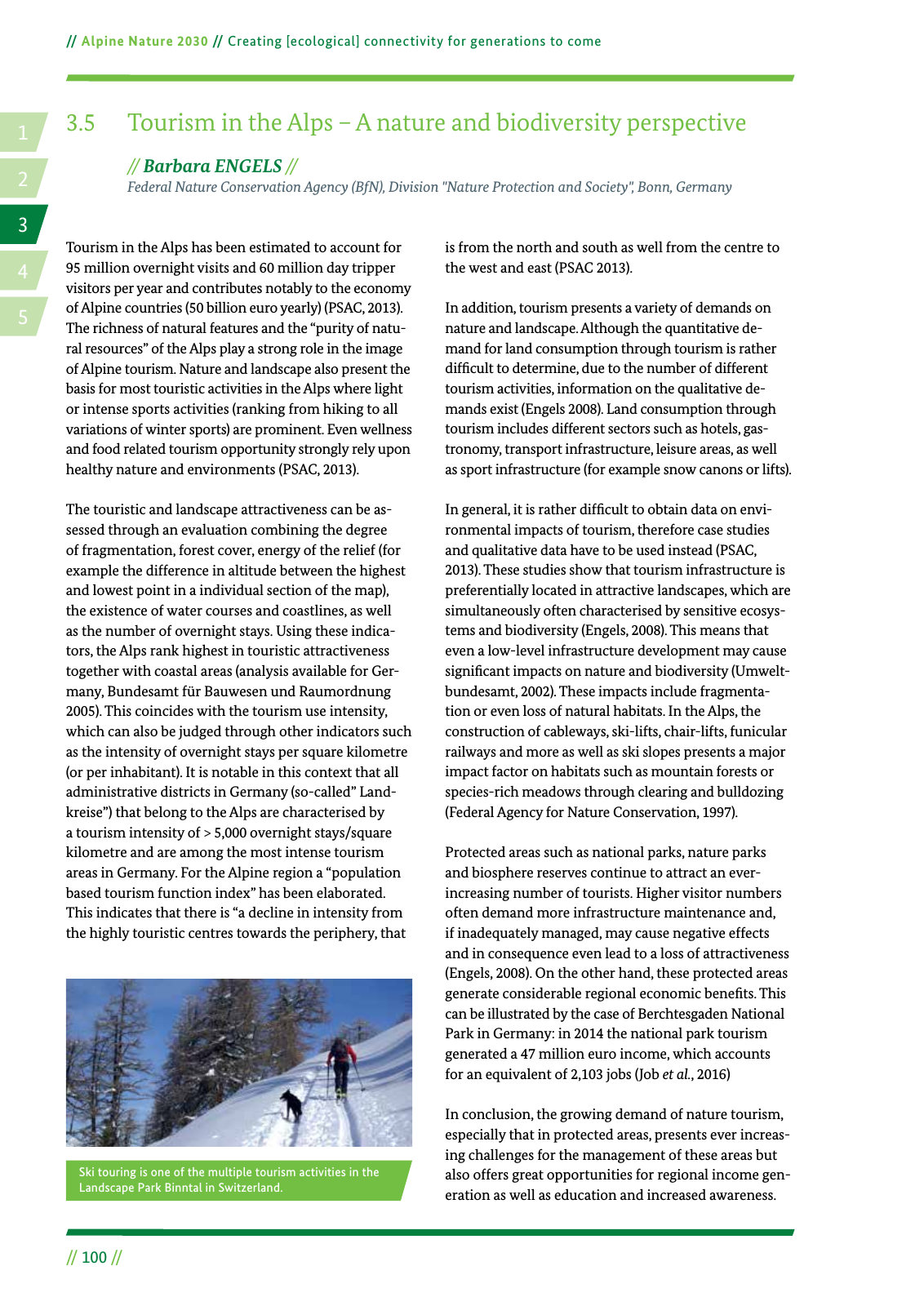14 2 5 3 Alpine Nature 2030 Creating ecological connectivity for generations to come 100 3 5 Tourism in the Alps A nature and biodiversity perspective Barbara ENGELS Federal Nature Conservation Agency BfN Division Nature Protection and Society Bonn Germany Tourism in the Alps has been estimated to account for 95 million overnight visits and 60 million day tripper visitors per year and contributes notably to the economy of Alpine countries 50 billion euro yearly PSAC 2013 The richness of natural features and the purity of natu ral resources of the Alps play a strong role in the image of Alpine tourism Nature and landscape also present the basis for most touristic activities in the Alps where light or intense sports activities ranking from hiking to all variations of winter sports are prominent Even wellness and food related tourism opportunity strongly rely upon healthy nature and environments PSAC 2013 The touristic and landscape attractiveness can be as sessed through an evaluation combining the degree of fragmentation forest cover energy of the relief for example the difference in altitude between the highest and lowest point in a individual section of the map the existence of water courses and coastlines as well as the number of overnight stays Using these indica tors the Alps rank highest in touristic attractiveness together with coastal areas analysis available for Ger many Bundesamt für Bauwesen und Raumordnung 2005 This coincides with the tourism use intensity which can also be judged through other indicators such as the intensity of overnight stays per square kilometre or per inhabitant It is notable in this context that all administrative districts in Germany so called Land kreise that belong to the Alps are characterised by a tourism intensity of 5 000 overnight stays square kilometre and are among the most intense tourism areas in Germany For the Alpine region a population based tourism function index has been elaborated This indicates that there is a decline in intensity from the highly touristic centres towards the periphery that is from the north and south as well from the centre to the west and east PSAC 2013 In addition tourism presents a variety of demands on nature and landscape Although the quantitative de mand for land consumption through tourism is rather dif cult to determine due to the number of different tourism activities information on the qualitative de mands exist Engels 2008 Land consumption through tourism includes different sectors such as hotels gas tronomy transport infrastructure leisure areas as well as sport infrastructure for example snow canons or lifts In general it is rather dif cult to obtain data on envi ronmental impacts of tourism therefore case studies and qualitative data have to be used instead PSAC 2013 These studies show that tourism infrastructure is preferentially located in attractive landscapes which are simultaneously often characterised by sensitive ecosys tems and biodiversity Engels 2008 This means that even a low level infrastructure development may cause signi cant impacts on nature and biodiversity Umwelt bundesamt 2002 These impacts include fragmenta tion or even loss of natural habitats In the Alps the construction of cableways ski lifts chair lifts funicular railways and more as well as ski slopes presents a major impact factor on habitats such as mountain forests or species rich meadows through clearing and bulldozing Federal Agency for Nature Conservation 1997 Protected areas such as national parks nature parks and biosphere reserves continue to attract an ever increasing number of tourists Higher visitor numbers often demand more infrastructure maintenance and if inadequately managed may cause negative effects and in consequence even lead to a loss of attractiveness Engels 2008 On the other hand these protected areas generate considerable regional economic bene ts This can be illustrated by the case of Berchtesgaden National Park in Germany in 2014 the national park tourism generated a 47 million euro income which accounts for an equivalent of 2 103 jobs Job et al 2016 In conclusion the growing demand of nature tourism especially that in protected areas presents ever increas ing challenges for the management of these areas but also offers great opportunities for regional income gen eration as well as education and increased awareness Ski touring is one of the multiple tourism activities in the Landscape Park Binntal in Switzerland

Hinweis: Dies ist eine maschinenlesbare No-Flash Ansicht.
Klicken Sie hier um zur Online-Version zu gelangen.
Klicken Sie hier um zur Online-Version zu gelangen.